Genus Ursus Phylum Chordata Order Carnivores | Family Ursidae Rank Subspecies | |
 | ||
Scientific name Ursus americanus floridanus Similar Bear, American black bear, Bears, Florida panther, Mammal | ||
Living with florida black bears
The Florida black bear (Ursus americanus floridanus) is a subspecies of the American black bear that has historically ranged throughout most of Florida and southern portions of Alabama, Georgia, and Mississippi. The large black-furred bears live mainly in forested areas and have seen recent habitat reduction throughout the state.
Contents
- Living with florida black bears
- Plight of florida black bear
- Physical
- Behavior
- Habitat
- Range
- Diet
- Conservation
- Biological status review
- Florida Bear hunt
- Discouraging bears from human occupied areas
- Legislative action
- Endangered Species Act Petition
- References
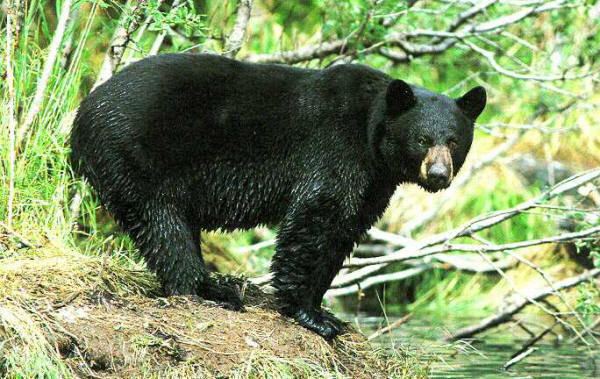
Plight of florida black bear
Physical
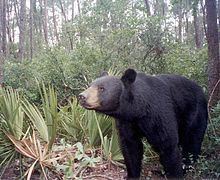
Florida black bears are typically large-bodied with shiny black fur, a light brown nose and a short stubby tail. A white chest patch is also common on many but not all the bears. It is currently Florida's largest terrestrial mammal with an average male weight of 300 pounds (140 kg) and a few have grown above 500 pounds (230 kg). Females generally weigh less on average. Average adults have a length of between 4 feet (120 cm) and 6 feet (180 cm), and they also stand between 2.5 feet (76 cm) and 3.5 feet (110 cm) high at the shoulder.
Behavior
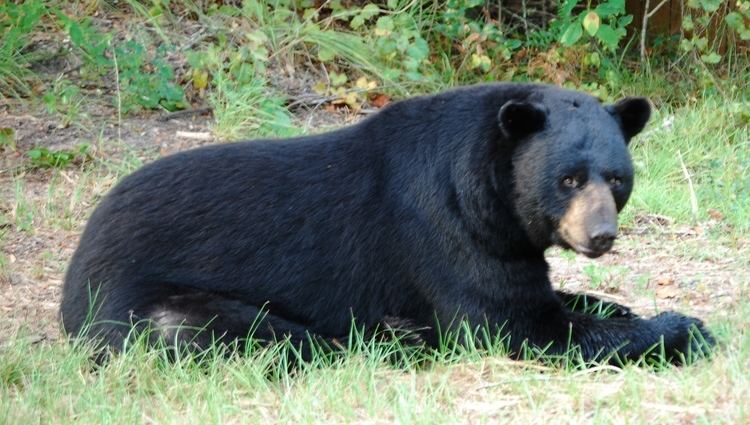
Florida black bears are mainly solitary, except when in groups or pairings during mating season. Although they are solitary mammals, in general, most are not territorial, and typically do not defend their range from other bears. Black bears have good eyesight, acute hearing and an excellent sense of smell .
Habitat
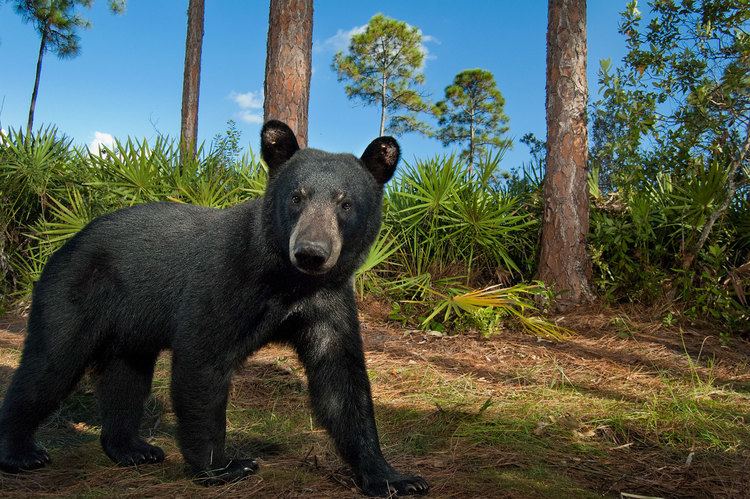
Florida black bears live mainly in forested habitats, and are common in sand-pine scrub, oak scrub, upland hardwood forests and forested wetlands. Black Bears in Southern Florida are the only subspecies to live in a Sub-Tropical region. To a lesser extent it also inhabits dry prairie and tropical hammock.
Range
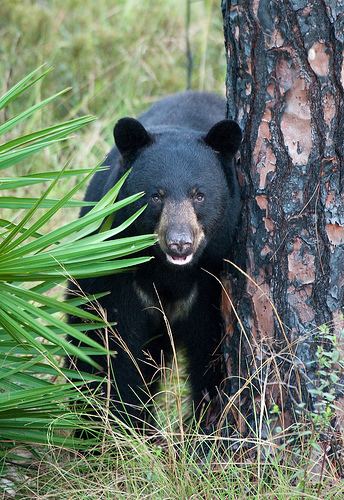
Before Florida was settled by Europeans, Florida black bears occupied all of the Florida mainland, and even many of the Florida Keys, with a population around 12,000. The current range is much more sporadic with isolated groups living mainly in protected areas in Florida, Southern Alabama, Southern Georgia and Southern Mississippi. Most major populations of Florida black bears live in protected areas. These include Ocala National Forest, Big Cypress National Preserve, Everglades National Park, Apalachicola National Forest, Osceola National Forest and Okefenokee National Wildlife Refuge. A study of the Okefenokee-Osceola population found over 500 bears in two study areas. The current bear population in Florida is estimated at more than 4,000 bears.
Diet

Florida black bears are omnivores and their diet varies greatly with the seasons, likely because many of their preferred species of flora and fauna are seasonal. In the spring they mainly consume Sabal palmetto, Thalia geniculata, Sus scrofa, Bombus bimaculatus and Camponotus species. In the summer they primarily eat Serenoa repens, Ilex glabra, Rubus species, Phytolacca rigida, Vaccinium species, Camponotus species, and Anisomorpha buprestoides. In the fall, they eat Serenoa repens, Ilex glabra, Nyssa biflora, Vespula species, Apis mellifera, and Dasypus Novemcinctus.
Conservation
Habitat loss is greatly affecting Florida Black Bear populations. Nearly 20 acres (81,000 m2) of wildlife habitat are lost to new development every hour in Florida. Bears being injured or killed by motorists is another threat to regional populations. Since 1976 there have been more than 1,356 documented cases of bears being killed in Florida. Over 100 bears are killed on Florida roadways each year, and in 2002 a record 132 deaths occurred. That makes roadkill the number one cause of bear death in the state, with 89.5% of bear deaths since 1994 being attributed to such crashes. The Florida State Legislature outlawed the hunting of the Florida black bear in 1994.
Biological status review
On June 27, 2012 the Florida Fish and Wildlife Conservation Commission (FWC) delisted the Florida Black Bear despite FWC biologist and affiliates concerns regarding low genetic diversity. According to the report, "Loss of genetic variation may reduce the ability of individuals to adapt to changes in the environment, cause inbreeding depression (Ebert et al. 2002), and increase the probability of extinction (Westemeier et al. 1998)." The decision was based on population size alone. Although FWC said the most recent statewide estimate of the bear population was done in 2002 and new numbers won't be updated until 2016.
In addition to delisting the Florida Black Bear from the list of threatened species rules were adopted "stating it is still illegal to injure or kill a bear in this state, or possess or sell bear parts."
Florida Bear hunt
On August 3, 2015, FWC began selling Special-Use permits for the hunting season beginning on October 24, 2015. The commissioners voted to proceed with it despite public opposition. Of the 40,000 people who responded to the commission's request to comment on the proposed hunt, 75 percent said they wanted no bear hunt, according to the Tampa Bay Times on October 27, 2015. By August 23, 3,778 permits were sold.
On the first day of the hunt 207 bears were killed, but 295 were taken after 2 days.
On June 22, 2016, after hours of testimony from Florida citizens, a vote came for the 2016 hunt. Four out of seven commissioners including, Ron Bergeron, Charles Spotswood, Bo Rivard, and Brian Yablonski, agreed to look into further issues and concerns of the citizens while postponing a decision for future hunts.
Following this decision, many grassroots efforts continued to help reduce human and bear interactions. Local citizens worked with their counties to encourage bear resistant trash cans and bear friendly ordinances to be put in place. Seminole County, Florida became the first to pass such an ordinance.
Discouraging bears from human occupied areas
Bear sightings have been increasing in Florida in recent years and the Florida Fish and Wildlife Conservation Commission has posted a number of actions that can be taken to discourage bears from encroaching into human occupied areas. Most important has been the prevention of allowing access to food sources such as those maintained for pets or livestock. In residential areas, keeping garbage cans in garages or putting locks on lids as well as discouraging the use of outdoor feeders and keeping pet foods outdoors. Electric fences have also proven successful as a means to secure perimeters from bear incursions. Keep ripe fruit and garden vegetables picked in suburban residential and rural residential areas and cleaning outdoor grills have also reduced unplanned human-black bear interactions. Motion activated alarms have also been found to be effective in scaring bears away.
Legislative action
On December 11, 2015, then state Senator (now-U.S. Congressman) Darren Soto (D-FL) filed, along with co-sponsor state Senator Eleanor Sobel (D-FL), S.B. 1096 The Black Bear Habitat Restoration Act. This bill would require the Fish and Wildlife Conservation Commission, the Department of Agriculture and Consumer Services, and the Department of Environmental Protection to create an account within the Nongame Wildlife Trust Fund to assist with funding for bear-resistant trash cans and take certain measures to conserve bear habitat.
A House Bill, H.B. 1055, was filed on December 28, 2015 by Representative Mark S. Pafford and co-sponsored by Representative Dwight Dudley which coincides with S.B. 1096. This bill states it would require similar measures stated in S.B. 1096. Conservation efforts would include changing schedules for controlled burns in bear habitat, permanently banning the harvest of saw palmetto berries, and ban sales of timbering rights to acorn producing oaks. The mention of prohibiting the sale of timber rights on state land was in response to land usage in the Bear Management plan which also included grain farming and cattle ranching on state land. The bills would also require a panel of five biologists and wildlife ecologists appointed by the senate to oversee the Black Bear Habitat Restoration Act. Neither bill however, received much interest in the House or the Senate and both died.
Endangered Species Act Petition
On March 17, 2016 Various conservation groups throughout Florida led by the Center for Biological Diversity petitioned the U.S. Department of Interior to request the Florida Black Bear be listed on the Federal Endangered Species Act.
